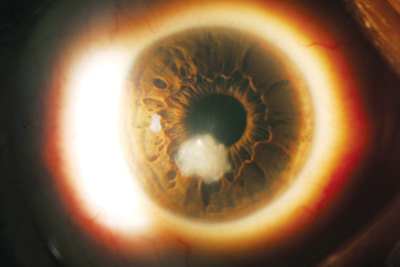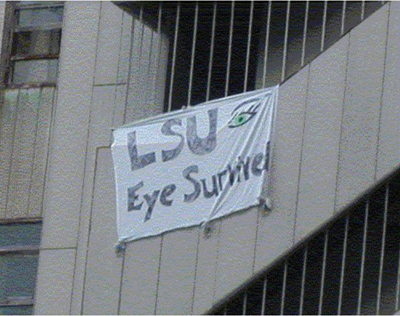The CDC was reviewing reports of 109 cases of suspected fungal keratitis, and federal and state health officials have interviewed 30 of those patients. Of the 28 who wore soft contact lenses, 21 reported using ReNu brand contact lens care products and five reported using a combination of ReNu and products manufactured by other companies.
"This is quickly becoming a cause for alarm," said Eduardo C. Alfonso, MD, chair and professor of ophthalmology at Bascom Palmer Eye Institute of the University of Miami, in a press release announcing the increased incidence of the infection in south Florida. "We have mobilized cornea specialists throughout the world to hasten our understanding of the spread of this particular type of fungus and have learned of a sudden increase in the number of cases in the U.S., Singapore, Malaysia and Australia."
 |
| Fusarium keratitis is not generally associated with contact lens wear. |
B&L placed ads in USA Today and regional newspapers on April 14 and 16 featuring an open letter to consumers from Bausch & Lomb Chairman and CEO Ron Zarrella explaining the situation and providing guidance on alternatives.
"Bausch & Lomb's first priority is the health and safety of consumers," said Zarrella in his letter. "If there is a problem with our product, we'll find it and we'll fix it. If there's not, when we come back you'll be able to know with absolute certainty that we've taken every possible step to ensure your safety."
Reports of an outbreak of contact lens-related Fusarium keratitis in Singapore and Hong Kong first came to Bausch & Lomb's attention in mid-February.
Normalcy Remains Elusive Post-Katrina
AS ARE THE REST OF THE POPULAtion of New Orleans and its environs, ophthalmologists are struggling to regain the normalcy of the antediluvian Gulf Coast that was washed away in Hurricane Katrina. There are pockets of progress, however.
The devastation did not deter the New Orleans Academy of Ophthalmology from hosting its 55th annual symposium in mid-March. "It was the hardest meeting I've ever had to do but I'm so pleased we did it," says Amber Howell, executive director of NOAO, whose membership base is in Louisiana, Mississippi and Alabama. "It was something we just had to do—a labor of love."
Ms. Howell says the meeting hotel was the only change symposium organizers faced, as the Federal Emergency Management Agency was using the original hotel until April for assistance purposes.
NOAO President Scott D. Lanoux, MD, says he decided mid-September, just days after Katrina, to proceed with the symposium on "blind faith." All of the symposium speakers attended, though many were reluctant at first to come to New Orleans, and some had even scheduled new plans. But looking back, "it was the right call," Dr. Lanoux says. "We've never missed a year."
Attendance at the symposium, was about 275, down from 375 in 2005, and more than 400 in 2004. But the meeting brought a sense of normalcy for the members who attended, Ms. Howell says.
One problem the NOAO faced in planning the meeting was locating members, many of whom had relocated, even temporarily. Ms. Howell says several members had relocated to other cities and had joined ophthalmic practices in their new homes, but still wanted to come back to attend the symposium.
 |
| The Louisiana State University Eye Center and other eye care centers on the Gulf Coast are slowly rebounding. Henry Alexander Leder, MD |
The group was also fielding calls from patients who are looking for information on their ophthalmologist and their practice, or just their patient records. "So many of our doctors lost everything," she says. One surgeon reported his office was just a pile of cinder blocks. Another ophthalmologist said she lost her whole practice and would not be starting up again in New Orleans.
Dr. Lanoux's practice was located at Memorial Hospital, which was shut down due to the now-infamous alleged-euthanasia cases during the hurricane. He and his partner moved their ophthalmic practice to a 1,400-square-foot office in Metairie, an office by far smaller than the 6,000-square-foot office the practice where it was formerly located. Dr. Lanoux's office equipment and patient records were salvageable, but his once very busy office now only sees about 60 percent of its former client base.
Joel M. Knight, an ophthalmologist at Eye Associates of the South, Cedar Lake Surgery Center, in Biloxi, Miss., says Katrina left his practice "a mess." His practice's main office in Biloxi was one block off the beach, and three feet of water "pretty much destroyed most everything in the office," including electronics, chairs, stands, slit lamps, computers and furniture.
The five ophthalmologists in his practice are now working in more cramped quarters, sharing four exam lanes in their satellite Biloxi office, which only sustained some ceiling damage, and is now the practice's main office.
The former main office in Biloxi catered to a largely older clientele and "that clientele is gone," he says, having relocated to other cities. His practice is only seeing about 75 percent or so of its former client base, but that is OK for now, he says, because with the smaller workspace, the doctors in his practice can't see as many patients in a day anyway. The five doctors have had to adjust their schedules, some working part-time, due to the less exam space.
Having been in practice for 20 years in the Biloxi area, it wasn't "an option to pick up and move elsewhere," Dr. Knight says, and that it would have been harder to pick up and start elsewhere, economically and emotionally. "It's my home."
Dr. Knight says his practice survived thanks to multiple office locations. The biggest impact he's felt from Katrina is in the referral patterns. Patients used to be referred to practices in New Orleans, 90 miles away, for certain procedures, "where facilities are no more," he says. Now, patients have to travel farther for certain referral services and complicated AMD procedures. Dr. Knight says he is also performing more retina procedures himself in his office.
Natalie Loyacano, a certified ophthalmic technician and immediate past president of the Association of Technical Personnel in Ophthalmology, says the Eye Clinic at Louisiana State University experienced some flooding on the first floor of the building, which caused electrical problems. While no office equipment was affected, the practice relocated to its Baton Rouge satellite office and due to the relocation, lost some of its patients for convenience reasons, she says.
Mrs. Loyacano, who now works in an ophthalmic practice in Mississippi, says that for months after Katrina hit, it was common for medical practices to see many patients who didn't have health insurance, due to layoffs from their jobs at schools, casinos and other businesses no longer there due to Katrina.
The personal property of these people, aside from their ophthalmic connections, was affected as well. Ms. Howell evacuated to New York for four months, after four and a half feet of water invaded her home in New Orleans; luckily, another family property sustained minor damage and her family has since taken up main residence there.
Dr. Lanoux's Metairie home sustained some flooding, and after a temporary relocation to Baton Rouge, he and his family returned to fix their home.
Dr. Knight's home in Ocean Springs, east of Biloxi, "was destroyed," taking in eight to 10 feet of water before blowing out the doors and windows and taking all of his family's possessions out the back. His family has relocated to another home in Ocean Springs with what they were able to salvage, and he is just grateful they were "more fortunate than some people."
Marguerite McDonald, MD, a New Orleans refractive and corneal surgeon, and her husband are living in the city as she interviews for a new position elsewhere. They lost their weekend home in the storm, and once they move they will continue to use their other New Orleans home for weekend visits. She is in "the final stages of deciding where to start practicing again," and has already started to sell much of her charts and equipment from her former practice. "Basically, it won't work just now to have a high-end refractive practice in this devastated city where 80 percent of the homes are still uninhabitable and from which many of the more affluent folks have fled," she says.
Dr. Lanoux says not too many ophthalmologists have left the area, compared to specialists in other medical fields, such as radiologists. Many ophthalmic practices are working in smaller office space and seeing a reduced patient base, though practices in less-affected areas may even see an increase in patients due to relocation, he says.
Mrs. Loyacano hopes that with the 2007 American Academy of Ophthalmology congress coming to New Orleans, doctors will go off the beaten path during their visit and see what happened in areas hardest hit. But she sees ophthalmic practices coming back to the area, as well as businesses in general. "It's definitely coming back," Mrs. Loyacano says. "[I have] faith and hope that things will come back stronger and better than before Katrina."
Dr. Lanoux agrees the situation has improved greatly in the past few months as the return to a sense of normalcy continues on the Gulf Coast nine months after Katrina. As businesses reopen and people return to the area and their lives return to normal routines, the ophthalmic community will be revived as well. "We're open for business," he says.



